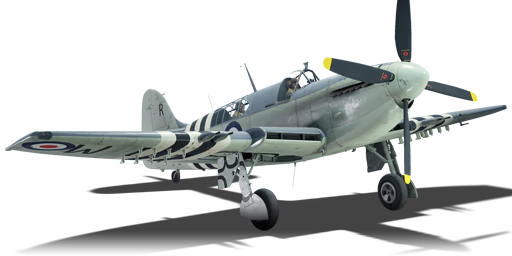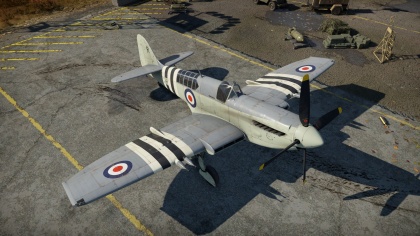Firefly FR Mk V
Contents
| This page is about the aircraft Firefly FR Mk V. For other uses, see Firefly (Disambiguation) |
Description
The Firefly FR Mk V is a Rank III British naval fighter
with a battle rating of 4.0 (AB/SB) and 3.7 (RB). This aircraft was introduced in Update 1.49 "Weapons of Victory".
General info
Flight Performance
| Characteristics | |||||||
|---|---|---|---|---|---|---|---|
| Stock | |||||||
| Max Speed (km/h at 5,181 m) |
Max altitude (meters) |
Turn time (seconds) |
Rate of climb (meters/second) |
Take-off run (meters) | |||
| AB | RB | AB | RB | AB | RB | ||
| 518 | 503 | 10050 | 29.9 | 30.8 | 9.5 | 9.5 | 450 |
| Upgraded | |||||||
| Max Speed (km/h at 5,181 m) |
Max altitude (meters) | Turn time (seconds) | Rate of climb (meters/second) |
Take-off run (meters) | |||
| AB | RB | AB | RB | AB | RB | ||
| 591 | 554 | 10050 | 26.2 | 28.0 | 22.5 | 13.5 | 450 |
Details
| Features | ||||
|---|---|---|---|---|
| Combat flap | Take-off flap | Landing flap | Air brakes | Arrestor gear |
| ✓ | ✓ | ✓ | X | ✓ |
| Limits | ||||
|---|---|---|---|---|
| Wing-break speed (km/h) |
Gear limit (km/h) |
Combat flap (km/h) |
Max Static G | |
| + | - | |||
| 720 | 280 | 700 | ~9 | ~6 |
| Optimal velocities | |||
|---|---|---|---|
| Ailerons (km/h) |
Rudder (km/h) |
Elevators (km/h) |
Radiator (km/h) |
| < 321 | < 400 | < 410 | > 250 |
| Compressor (RB/SB) | ||
|---|---|---|
| Setting 1 | ||
| Optimal altitude | 100% Engine power | WEP Engine power |
| 2,400 m | 1,510 hp | 2,166 hp |
| Setting 2 | ||
| Optimal altitude | 100% Engine power | WEP Engine power |
| 6,400 m | 1,410 hp | 2,002 hp |
Survivability and armour
- 42.8 mm Bulletproof glass in cockpit front.
- 12.7 mm Steel plate behind the pilot.
- Critical components located at the front of aircraft (fuel, pilot, engine, controls)
Armaments
Offensive armament
The Firefly FR Mk V is armed with:
- 4 x 20 mm Hispano Mk.V cannons, wing-mounted (175 RPG outer + 145 RPG inner = 640 total)
Suspended armament
The Firefly FR Mk V can be outfitted with the following ordinance:
- Without load
- 2 x M.C. 1,000 lb Mk.I bombs
- 16 x 76 mm RP-3 rockets
- 8 x 76 mm RP-3 rockets + 2 x 250 lb bombs
- 8 x 76 mm RP-3 rockets + 2 x G.P. 500 lb Mk.IV bombs
Usage in the battles
This aircraft has 2 ways to be used. The first and the recommended method is as a strike fighter with either the 2x1000lbs or the 16x76mm HVAR rockets. However the aircraft will be rather sluggish even fully upgraded when compared to other aircraft which can do this role, like the P-47 Thunderbolt. However this does have 16 rockets to strafe with. Return to base once payload is expended. The second way to use this aircraft is to climb to 6km and intercept bombers. The Firefly comes with four 20mm Hispanos that will make quick work of anything regardless of size.
Manual Engine Control
| MEC elements | ||||||
|---|---|---|---|---|---|---|
| Mixer | Pitch | Radiator | Supercharger | Turbocharger | ||
| Oil | Water | Type | ||||
| Controllable | Controllable | Not controllable | Controllable | Combined | Controllable | Not controllable |
Modules
| Tier | Flight performance | Survivability | Weaponry | ||
|---|---|---|---|---|---|
| I | Fuselage Repair | Radiator | |||
| II | Compressor | Airframe | |||
| III | Wings Repair | Engine | |||
| IV | Engine Injection | Cover | |||
Pros and cons
Pros:
- Faster than the Firefly Mk. I with a better roll rate thanks to its more powerful engine and clipped wings.
- One of the earliest planes with Hispano Mk. V cannons. Much larger ammo load with much less of a tendency to overheat than the Mk. II
- Same good bomb load but double the amount of rockets available to the pilot.
- Has an interceptor spawn, which can be useful.
Cons:
- Less manoeuvrable overall than the Firefly Mk. I aside from the roll rate.
- Somewhat large target for a single-engine fighter.
- Still rather slow in comparison to other fighters at its rank.
- Below average climb rate compared to Spitfires.
History
The Fairey Firefly had entered service in 1943 and served successfully in the closing stages of the Second World War as a multi-role, carrierborne fighter/strike aircraft. In 1944 a Rolls-Royce Griffon 72 was fitted to the Firefly for testing; the resulting improvements led to the Griffon 74 powered Firefly Mk.IV which entered service in 1947. The Mk.IV replaced the earlier three bladed propeller with a four bladed unit fitted to the new engine, and moved the radiators from the chin position to underneath the wings. The wings were also clipped to increase the roll rate. The leading edge of the tail fin was also extended and two under wing fairings carried fuel and a radar scanner in port and starboard respectively.
The Firefly Mk.V built on the success of the previous variant with further modifications. For specialized roles, sub variants of the Firefly included a number of internal changes for the standard day fighter/reconnaissance variant, night fighter and anti-submarine aircraft. Power folding wings were also introduced during the life of the Mk.V which greatly assisted the efficiency of deck operations.
812 Naval Air Squadron was the first front line unit to re-equip with the Mk.V, at Eglinton in July 1948. When the Korean People’s Army crossed the 38th Parallel in June 1950, Korea was plunged into war and the carrierborne aircraft of the Fleet Air Arm were in action within days of the outbreak of hostilities. HMS Triumph was the first British carrier in theatre, but the embarked 827 NAS were actually still operating Second World War vintage Firefly Mk.Is. It was the Mk.V which replaced it in theatre which proved to be the most prolific variant of the conflict, being operated by 810, 812, 817, 821 and 825 Naval Air Squadrons. The Firefly was regularly engaged in strikes against key infrastructure such as bridges, railways, harbour installations and industrial sites. Operating in a range of conditions including sub-zero temperatures and storms, the Fireflies served alongside Seafires and Sea Furies to maintain an impressive rate of operations, proving to be resilient to the elements and the rigours of continued deck operations in anger. In 1952 a record-breaking day of operations was achieved from HMS Ocean when Fireflies and Sea Furies flew 123 sorties in a single day. Fireflies of 825 NAS were also involved in ground attack sorties during the 1954 Malayan Emergency.
Post-war, the Firefly served as an export aircraft with Canada, Australia, Denmark, the Netherlands, Ethiopia, Thailand, Sweden and India. The venerable aircraft left the service of the Fleet Air Arm in 1956, after 13 years of operations.
Media
An excellent addition to the article will be video guides, as well as screenshots from the game and photos.
Read also
Links to the articles on the War Thunder Wiki that you think will be useful for the reader, for example,
- reference to the series of the aircraft;
- links to approximate analogues of other nations and research trees.
Sources
Paste links to sources and external resources, such as:
- topic on the official game forum;
- page on aircraft encyclopedia;
- other literature.





